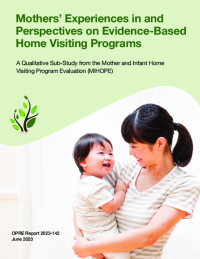Mothers’ Experiences in and Perspectives on Evidence-Based Home Visiting Programs
A Qualitative Sub-Study from the Mother and Infant Home Visiting Program Evaluation (MIHOPE)

Introduction
Home visiting is a service delivery strategy with decades of research supporting these interventions as a lever to improve a range of outcomes in the early childhood years. However, prior research has found that engagement in home visiting programs varies widely among families enrolled. Though engagement is multi-faceted and operationalized differently across studies, one important aspect of engagement is the relationship between the home visitor and the parent. Indeed, earlier quantitative research has found a positive association between mothers’ reports of the quality of their relationships with home visitors and program retention or other participation outcomes. Qualitative research has also found that one of the reasons mothers cite for early attrition is that they did not trust or lost trust in their home visitor, a finding that aligns with the broader literature identifying trust as a key aspect of relationship quality. Yet despite the potential importance of trust between home visitors and parents, it is not always clear how trust and strong working relationships with home visitors are built.
This report explores one aspect of family engagement, which is how mothers with low incomes who participated in evidence-based home visiting programs perceived their experiences and relationships with home visitors, with a particular focus on building trusting relationships. In doing so, it represents one of few published studies that brings to light the client or participant side of home visiting, using the mothers’ own words. It uses qualitative information collected from semi-structured interviews with 74 mothers who were part of the Mother and Infant Home Visiting Program Evaluation (MIHOPE). MIHOPE is the national evaluation of the federal Maternal, Infant, and Early Childhood Home Visiting (MIECHV) Program in its early years. The interviews and findings are based primarily on mothers’ reflections on their home visiting experiences about 3.5 years after services ended, although nine mothers were still involved in home visiting at the time of the interviews.
Research Questions
Five main themes were identified and are discussed in detail in the report:
- Why did mothers decide to enroll in home visiting?
- How did home visiting help mothers in the long-term participation group?
- How was trust with home visitors built among long-term participators?
- Why did mothers in the lower participation groups discontinue services?
- What were the long-term participation group mothers’ reflections on their experiences in home visiting when services ended?
Purpose
This report summarizes the results of a qualitative interview-based sub-study conducted among a sample of 74 program group mothers who received home visiting from evidence-based programs that were part of MIHOPE. It builds upon earlier reports published from MIHOPE, particularly the implementation research report, which presented findings from qualitative interviews with home visitors about how they describe their work and relationships with mothers. The overarching goal of the in-depth interviews with mothers was to shed light on why and how families engage for the time they do, including the role of the home visitor-parent relationship in a family’s engagement.
Key Findings and Highlights
- Although earlier research has found that alignment between a parent’s goals when enrolling and a home visitor’s emphasis on those goals is predictive of sustained participation, the majority of the mothers interviewed did not recall having clear expectations or an understanding of what home visiting entailed. While most mothers reported that they wanted to be a good parent, they did not have more specific outcomes or goals in mind when enrolling in home visiting beyond this. For example, some mothers said they enrolled in home visiting because they were young, facing motherhood for the first time, and were scared. This suggests that it may be important to understand that not all mothers have clarity about specific objectives when they enroll.
- The ways in which trust with home visitors is developed appeared to vary across mothers who were long-term participators in the programs. For example, while most mothers reported appreciating how their home visitors were non-judgmental and did not push them on behavioral change, a minority of mothers stated that they liked when their home visitor took a more directive, straight-talk approach with them. While some mothers said that trust was built because their home visitors helped in direct, tangible ways, a few mothers reported appreciating how their home visitor left the onus of following through on activities on the mother. These findings suggest that particular strategies that resonate with some mothers may not resonate as well with others.
- Mothers in the lower participation groups were a smaller part of the overall interview sample, but the reasons for their discontinuation of services largely align with the prior literature on early attrition. Some mothers in this study and others have noted that their life circumstances and stressors, including having to balance work or schooling and childcare or dealing with personal issues such as poor physical or mental health, did not allow them the capacity to stay engaged in home visiting. Other mothers described how they felt that they could and did figure things out on their own, meaning without a home visitor, with some stating that they had good social support systems.
Methods
The study team conducted in-depth interviews with 74 program group mothers from across six states who had received at least one home visit from a local program included in MIHOPE. The interview protocol was semi-structured in nature, which ensures consistency in the topics covered across respondents while allowing interviewers the flexibility to probe particular experiences in more depth. The interviews were conducted in person from May through November 2019, lasted up to 1.5 hours, and took place when the study child was 4.5 years old on average, several years after the mothers had joined the study and received their first home visit.
Although the study team was aiming for representation across different participation patterns based on quantitative measures of duration and dosage, mothers with lower participation in home visiting were more likely to have outdated contact information and were less likely to respond to contact attempts than mothers who were long-term participators. The findings are largely based on the experiences of mothers who participated in home visiting for an extended period of time (at least 10 months, but often one year or longer). As a qualitative inquiry with a sample of mothers who were mostly long-term participators in home visiting, the findings may not be generalizable to other mothers in the MIHOPE sample or the broader population of mothers who participate in early childhood home visiting programs.
Document Details
Helen Lee, Ashley Qiang, and Mallory Undestad. 2023. Mothers’ Experiences in and Perspectives on Evidence-Based Home Visiting Programs: A Qualitative Sub-Study from the Mother and Infant Home Visiting Program Evaluation (MIHOPE). OPRE Report 2023-142. Washington, DC: Office of Planning, Research, and Evaluation, Administration for Children and Families, U.S. Department of Health and Human Services.






